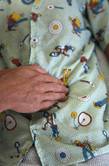 |
 |
 |

Traditional Nonsurgical GERD Treatments Not Impressive
But newer methods are replacing ones studied, experts say|
|
HealthDay
Friday, January 23, 2009
 FRIDAY, Jan. 23 (HealthDay News) -- Two traditional nonsurgical methods for correcting the anatomical flaw responsible for gastroesophageal reflux disease (GERD) produce only fair to middling results, a new study shows.
FRIDAY, Jan. 23 (HealthDay News) -- Two traditional nonsurgical methods for correcting the anatomical flaw responsible for gastroesophageal reflux disease (GERD) produce only fair to middling results, a new study shows.
Experts also noted that newer procedures have essentially taken the place of the techniques examined in the study.
GERD is a condition in which acid from the stomach backs up into the esophagus, because the valve separating the two is faulty. Its problems include heartburn, voice symptoms and cough. It can be treated by medications such as proton pump inhibitors, which reduce acid levels, but best results require surgery to repair the valve.
But surgery has its own problems, so nonsurgical methods of treating GERD have long been used. A new report in the January issue of the Archives of Surgery described how the two methods were put to the test in a study of 124 people treated at Emory University in Atlanta.
Of these, 68 underwent radiofrequency therapy, in which a beam of energy waves is aimed at the muscles of the esophagus and stomach to improve the function of the valve. The others had full-thickness plication, in which a long, narrow tube called an endoscope carries in instruments to suture the junction between the stomach and the esophagus.
In an average follow-up of six months, the incidence of moderate to severe heartburn decreased from 55 percent to 22 percent among those undergoing radiofrequency therapy. Use of GERD drugs decreased from 84 percent to 50 percent, and there were fewer reports of swallowing difficulties, voice symptoms and cough.
In the full-thickness plication group, moderate to severe heartburn decreased from 53 percent to 43 percent. Medication use decreased from 95 percent to 43 percent, and decreases were reported for voice symptoms and swallowing difficulties.
However, it is an underwhelming report, said Dr. Anthony A. Starpoli, a gastroenterologist at Lenox Hill Hospital in New York City, not only because better results were hoped for, but also because both methods are considered obsolete.
"We're talking about older, and not commercially available, techniques that have been supplanted by newer and more effective techniques to perform incisionless surgery," Starpoli said.
The full-thickness plication method was taken off the market last year, and radiofrequency therapy is rarely used in major centers, he noted.
Two new techniques now are used in many medical centers. One, whose brand name is EsophyX, allows surgical repair of the valve without an incision, with instruments inserted through the mouth.
A second technology, the EndoCinch, also uses instruments inserted down the throat, so that tissues can be stitched together to improve function of the valve.
"This EsophyX technique allows for robust remodeling of the anti-reflux barrier," said Starpoli, who uses it himself. Between 70 percent and 80 percent of those undergoing the procedure stop using GERD drugs, which is close to the 90 percent of those having standard surgery, he said.
"I probably do 100 reflux surgeries a year, and probably half to a third would be candidates for this [EsophyX]," said Dr. Reginald Bell, an assistant clinical professor of surgery at the University of Colorado Health Sciences Center in Denver.
That method is less aggressive than standard surgery, and so it is attractive to "a host of patients under medical [drug] therapy to whom current surgical technique does not appeal," Bell said. "Ordinary surgery is more aggressive than they need, their symptoms are not so bad that they need to go to surgery. This is really the first device to do internally what we know we can do externally."
Reports on the EndoCinch technique have been less enthusiastic; several European studies have said the beneficial effects of the procedure decrease or disappear with time.
HealthDay
Copyright (c) 2009 ScoutNews, LLC. All rights reserved.
Related News:
More News on this Date
Related MedlinePlus Pages:
| Home | Health Topics | Drugs & Supplements | Encyclopedia | Dictionary | News | Directories | Other Resources | |
| Disclaimers | Copyright | Privacy | Accessibility | Quality Guidelines U.S. National Library of Medicine, 8600 Rockville Pike, Bethesda, MD 20894 National Institutes of Health | Department of Health & Human Services |
Date last updated: 26 January 2009 |




